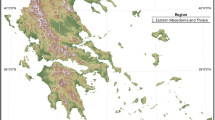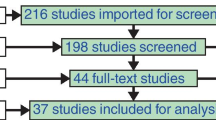Abstract
Land use changes are complex ecological processes driven by the interaction of biophysical and human related factors. The prediction of forest land use changes is important for sustainable forest management and biodiversity conservation. This study investigates the modelling process of the spatial dynamics of a forest ecosystem in north eastern Greece. For the prediction of forest expansion, based on land use data of the study area, a deterministic approach using logistic regression and heuristic methods of multi-criteria evaluation is adopted. The set of factors driving forest expansion are: the slope, the distance to roads, the distance to urban areas, the distance to forest, the soil depth, the soil erosion and the influence from the land uses of the neighbourhood. The spatial autocorrelation of driving factors is addressed using an autologistic regression model. The multicriteria evaluation approach is developed using weighted linear combination (WLC) and ordered weighted averaging (OWA) methods. In WLC method the relative importance of each factor was estimated using the analytical hierarchy process. In the OWA method, decision strategies are generated using a selection of relative linguistic quantifiers, which allow different Risk in decisions. The accuracy of the models produced was tested with real data for the year 2001 using the ROC validation method. All the methods produced satisfactory results. Autologistic regression showed slightly better performance than multicriteria evaluation methods due to higher degree of objectivity in defining the importance of driving factors for forest expansion.






Similar content being viewed by others
References
Adamakopoulos T, Gatzoyannis S, Poirazidis K (1995) Study on the assessment, the enhancement of the legal infrastructure and the management of the protected area in the forest of Dadia. Specific environmental study, conducted by the WWF Greece pursuant to the Ministerial Decret No. 6926/1990, Athens (in Greek)
Ananda J, Herath G (2003) The use of analytic hierarchy process to incorporate stakeholder preferences into regional forest planning. For Policy Econ 5:13–26
Augustin NH, Mugglestone MA, Buckland ST (1996) An autologistic model for the spatial distribution of wildlife. Appl Geogr 33:339–347
Bayala J, Kindt R, Belem M, Kalinganire A (2010) Factors affecting the dynamics of tree diversity in agroforestry parklands of cereal and cotton farming systems in Burkina Faso. New For 41:281–296
Boroushaki S, Malczewski J (2008) Implementation an extension of the analytical hierarchy process using ordered weighted averaging operators with fuzzy quantifiers in ArcGIS. Comput Geosci 34:399–410
Boyd DS, Foody GM, Ripple WJ (2002) Evaluation of approaches for forest cover estimation in the Pacific Northwest, USA, using remote sensing. Appl Geogr 22:375–392
Briassoulis H (2000) Analysis of land use change: theoretical and modelling approaches. The Web Book of Regional Science, Regional Research Institute, West Virginia University, Morgantown. Online at http://www.rri.wvu.edu/regscweb.htm
Burrough PA, McDonnell RA (1998) Principles of geographical information systems. Oxford University Press, Oxford
Burton PJ (1993) Some limitations inherent to static indices of plant competition. Can J For Res 23:2141–2152
Campbell KA, Dewhurst SM (2007) A hierarchical simulation-through-optimization approach to forest disturbance modelling. Ecol Model 202:281–296
Cohen J (1960) A coefficient of agreement for nominal scales. Educ Psychol Meas 20(1):37–46
D’Amato AW, Puettmann KJ (2004) The relative dominance hypothesis explains interaction dynamics in mixed species Alnus rubra/Pseudotsuga menziesii stands. J Ecol 92:450–463
Domenrich TA, McFadden D (1975) Urban travel demand: behavioural analysis. North-Holland, Amsterdam
Eastman RJ (2003) Idrisi Kilimanjaro, Manual. Clark Labs, Clark University, Worcester
ESRI (2008) ArcGIS 9.3. Redlands
Freeman EA, Moisen GG (2008) A comparison of the performance of threshold criteria for binary classification in terms of predicted prevalence and kappa. Ecol Model 217:48–58
Goldberg DE (1987) Neighborhood competition in an old-field plant community. Ecology 68:1211–1223
Gutierrez F, Navines R, Navarro P, Garcia-Esteve L, Subira S, Torrens M, Martin-Santos R (2008) What do all personality disorders have in common? Ineffectiveness and uncooperativeness. Compr Psychiatry 49:570–578
Hanspach J, Kuhn I, Pysek P, Boos E, Klotz S (2008) Correlates of naturalization and occupancy o introduced ornamentals in Germany. Perspect Plant Ecol 10:241–250
Ismail Z, Herrmann N, Rothenburg LS, Gotter A, Leibovitch FS, Rafi-Tari S, Blach SE, Lanctot KL (2008) A functional neuroimaging study of appetite loss in Alzheimer’s disease. J Neurol Sci 271:97–103
Jelinski D, Wu J (1996) The modifiable areal unit problem and implications for landscape ecology. Landsc Ecol 11(3):129–140
Jiang H, Eastman JR (2000) Application of fuzzy measures in multi-criteria evaluation in GIS. Int J Geogr Inf Sci 14(2):173–184
Journel AG, Huijbregts CJ (1978) Mining geostatistics. Academic Press, London
Lichstein JW, Simons TR, Shriner SA, Franzreb KE (2002) Spatial and autoregressive models in ecology. Ecol Monogr 72:445–463
Lopez AS, Civil RS, Jimenez JG, Ayanz JSM (2008) Integration of socio-economic and environmental factors for modelling long-term fire danger in Southern Europe. Eur J For Res 127:149–163
Malczewski J (1999) GIS and multicriteria decision analysis. Wiley, New York
Malczewski J (2006) Ordered weighted averaging with fuzzy quantifiers: GIS-based multicriteria evaluation for land use suitability analysis. Appl Earth Obs Geoinf 8:270–277
Malczewski J, Chapman T, Flegel C, Walters D, Shrubsole D, Healy MA (2003) GIS-multicriteria evaluation with ordered weighted averaging (OWA): case study of developing management strategies. Environ Plan 35(10):1769–1784
Marrocco C, Molinara M, Tortorella F (2006) Exploiting AUC for optimal linear combinations of dichotomizers. Pattern Recognit Lett 27:900–907
Mertens B, Lambin EF (1997) Spatial modelling of deforestation in southern Cameroon. Appl Geogr 17:143–162
Miller C, Urban DL (2000) Modeling the effects of fire management alternatives on Sierra Nevada mixed-conifer forests. Ecol Appl 10(1):85–94
Osborne PE, Alonso JC, Bryant RG (2001) Modelling landscape-scale habitat use using GIS and remote sensing: a case study with great bustards. Appl Ecol 38:458–471
Overmars KP, de Koning GHJ, Veldkamp A (2003) Spatial in multi-scale land use models. Ecol Model 164:257–270
Poirazidis K (2002) Systematic monitoring plan of Dadia-Leykimi-Soufli nature reserve. Record of landscape characteristic of Dadia forest in 2001, WWF-Greece, Athens, 38 pp (unpublished study—in Greek)
Reyer C, Guericke M, Ibisch PL (2009) Climate change mitigation via afforestation, reforestation and deforestation avoidance: and what about adaptation to environmental change? New For 38:15–34
Saaty TL (1977) A scaling method for priorities in hierarchical structures. Math Psychol 15:234–281
Saaty RW (1987) The analytic hierarchy process-what it is and how it is used. Math Model 9:161–176
Saaty TL (1994a) Highlights and critical points in the theory and application of the analytical hierarchy process. Eur J Oper Res 74:426–447
Saaty TL (1994b) The fundamentals of decision making and priority theory with the analytic hierarchy process. AHP series, vol VI. RWS Publication, Pittsburgh, p 527
Schmoldt DL, Kangas J, Mendoza GA, Pesonen M (2001) The analytic hierarchy process in natural resource and environmental decision making. Kluwer, Amsterdam
Serneels S, Lambin EF (2001) Proximate causes of land use change in Narok District Kenya: a spatial statistical model. Agric Ecosyst Environ 85:65–81
Simard SW, Zimonick BJ (2005) Neighborhood size effects on mortality, growth and crown morphology of paper birch. For Ecol Manag 214:251–265
Tortorella F (2005) A ROC-based reject rule for dichotomizers. Pattern Recognit Lett 26:167–180
Triantakonstantis DP, Kollias VJ, Kalivas DP (2006) Forest re-growth since 1945 in the Dadia forest nature reserve in northern Greece. New For 32:51–69
Tsai Y (2005) Quantifying urban form: compactness versus ‘sprawl’. Urban Stud 42(1):141–161
Tzeng HM, Yin CY (2008) Crisis management systems: staff nurses demand more support form their supervisors. Appl Nurs Res 21:131–138
Valente ROA, Vettorazzi CA (2008) Definition of priority areas for forest conservation through the ordered weighted averaging method. For Ecol Manag 256:1408–1417
Vardakis G, Ziangas E, Nakos G (1996) Land resource map of Greece. Map sheets of Mega Dereion and Soufli, scale 1:50.000. Forest Research Institute of Athens
Veldkamp A, Verburg PH (2004) Modelling land use change and environmental impact: introduction to the spatial issue. Environ Manag 72:1–3
Verburg PH, Veldkamp A (2005) Editorial: spatial modeling to explore land use dynamics. Int J Geogr Inf Sci 19:99–102
White R, Engelen G (2000) High resolution integrated modelling of the spatial dynamics of urban and regional systems. Comput Environ Urban Syst 23:383–400
Wu F (2002) Calibration of stochastic cellular automata: the application to rural-urban land conversions. Int J Geogr Inf Sci 16(8):795–818
Yager RR (1988) On ordered weighted averaging aggregation operators in multicriteria decision making. IEEE Trans Syst Man Cybern 18(1):183–190
Yager RR (1996) Quantifier guided aggregation using OWA operators. Intell Syst 11:49–73
Acknowledgments
The authors would like to express their deep appreciation to WWF-Greece for providing the digitized satellite image. We also thank the Forest Research Institute of the Ministry of Agriculture for providing the geological and soil data.
Author information
Authors and Affiliations
Corresponding author
Rights and permissions
About this article
Cite this article
Triantakonstantis, D.P., Kalivas, D.P. & Kollias, V.J. Autologistic regression and multicriteria evaluation models for the prediction of forest expansion. New Forests 44, 163–181 (2013). https://doi.org/10.1007/s11056-012-9308-x
Received:
Accepted:
Published:
Issue Date:
DOI: https://doi.org/10.1007/s11056-012-9308-x




